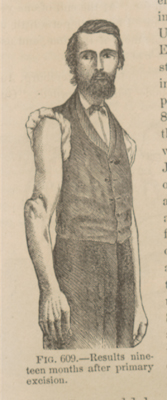Title: Lovell, C. H.
Source text: The Medical and Surgical History of the War of the Rebellion. (1861-65.), Part 2, Volume 2 (Washington, DC: Government Printing Office, 1876), 850.
Civil War Washington ID: med.d2e31332
TEI/XML: med.d2e31332.xml
CASE 1786.—Sergeant C. H. Lovell, Co. D, 14th New York Heavy Artillery, aged 24 years, was wounded at Cold Harbor, June 2, 1864, and taken to the 1st division, Ninth Corps, hospital. Surgeon M. K. Hogan, U. S. V., reported "a gunshot wound of the right arm with fracture of the condyles of the humerus, and that the patient was operated upon, by excision of the elbow, twenty hours after being wounded. On the 9th he was transferred to Lincoln Hospital, Washington, and thence to Philadelphia, entering Mower Hospital July 22d. Surgeon Joseph Hopkinson, U. S. V., recorded the operation as follows: "Gunshot fracture of lower third of right humerus. Excision of four inches of right humerus, commencing at a point one inch above the condyles, by a straight incision four and a half inches in length, over and in the line of the humerus. The patient was in good condition at the time of operation." On September 6, 1864, the patient was discharged and pensioned, his disability being rated one-half. Examiner J. B. Graves, of Corning, New York, September 8, 1864, reported: "Gunshot wound of right arm. Resection of humerus just above the elbow joint, three inches in extent." On June 29, 1865, he reported: "Pieces of bone are working out, and the wound discharging pus continually. Every attempt to use the arm inflames it and lays him up." On January 16, 1866, Dr. E. D. Hudson furnished the patient with a prothetic apparatus, which, from the outset, proved highly useful. At that time the arm was shortened nearly four inches, and slightly atrophied. There was no use of the forearm, but the functions of the hand were normal. When the apparatus was applied, however, the patient was able to lift his forearm and to carry at right angles from the body, and to raise a chair at an angle of 45 degrees. Dr. Hudson contributed the photograph of the pensioner, taken at this time, to the Museum. A reduced copy of it is represented in the adjacent wood-cut (FIG. 609). On October 22, 1866, Examiner J. B. Graves, who reports the patient to be suffering from caries of the lower end of the humerus, with a continuous discharge and pain, rates his disability total and permanent. A communication from Dr. H. C. May, late Assistant Surgeon of Volunteers, dated March 18, 1868, states that this man has been employed for two years as a fireman in a factory at Corning, New York, and is able to do any work at arm's length, like pitching wood, shoveling coal, etc. The Elmira board, consisting of Drs. H. S. Chubbuck, H. C. May, and George Dean, September 5, 1873, reported: " . . Circulation of arm good, and arm well nourished; disability total." This pensioner was paid to March 4, 1874.
